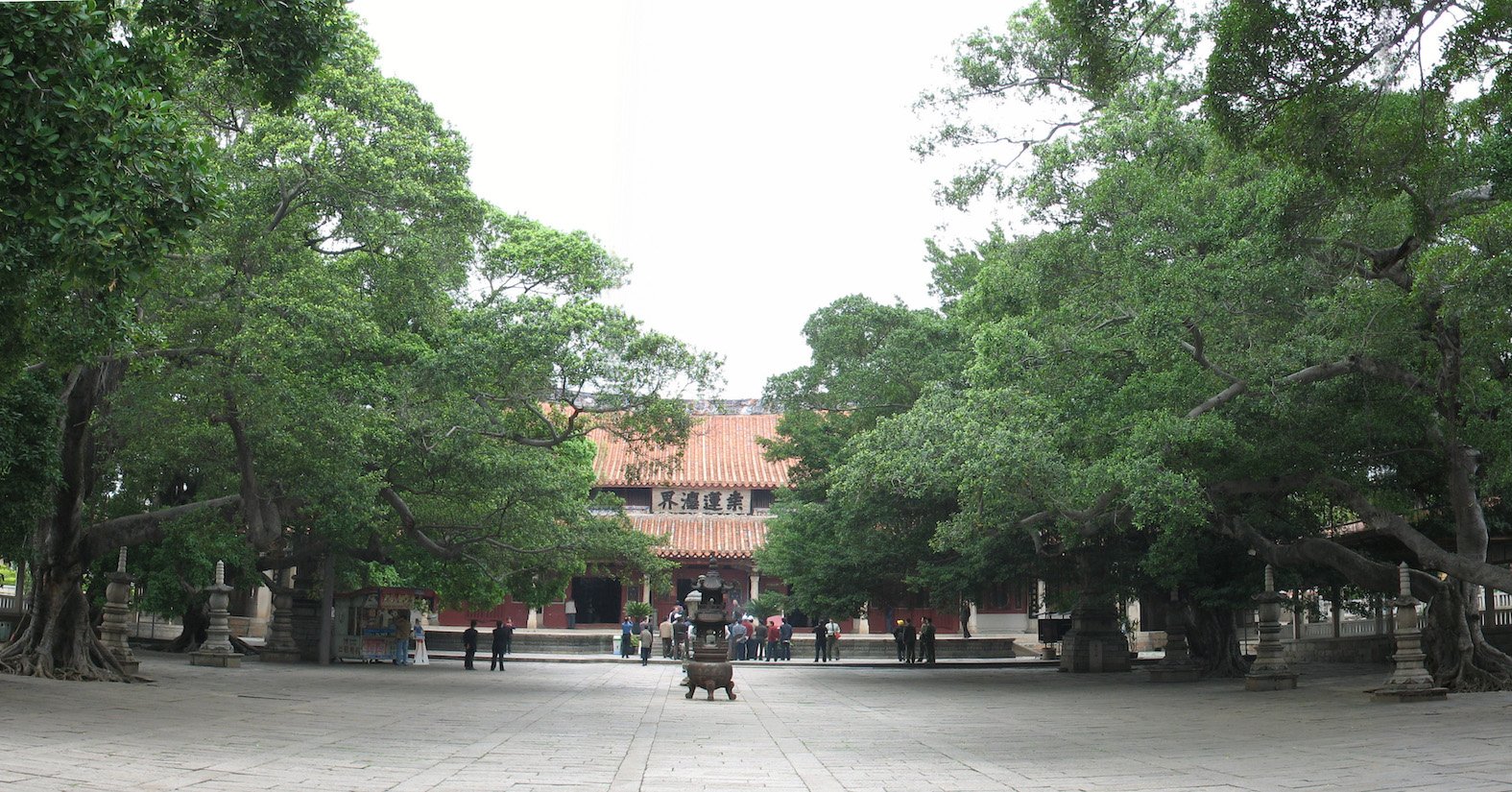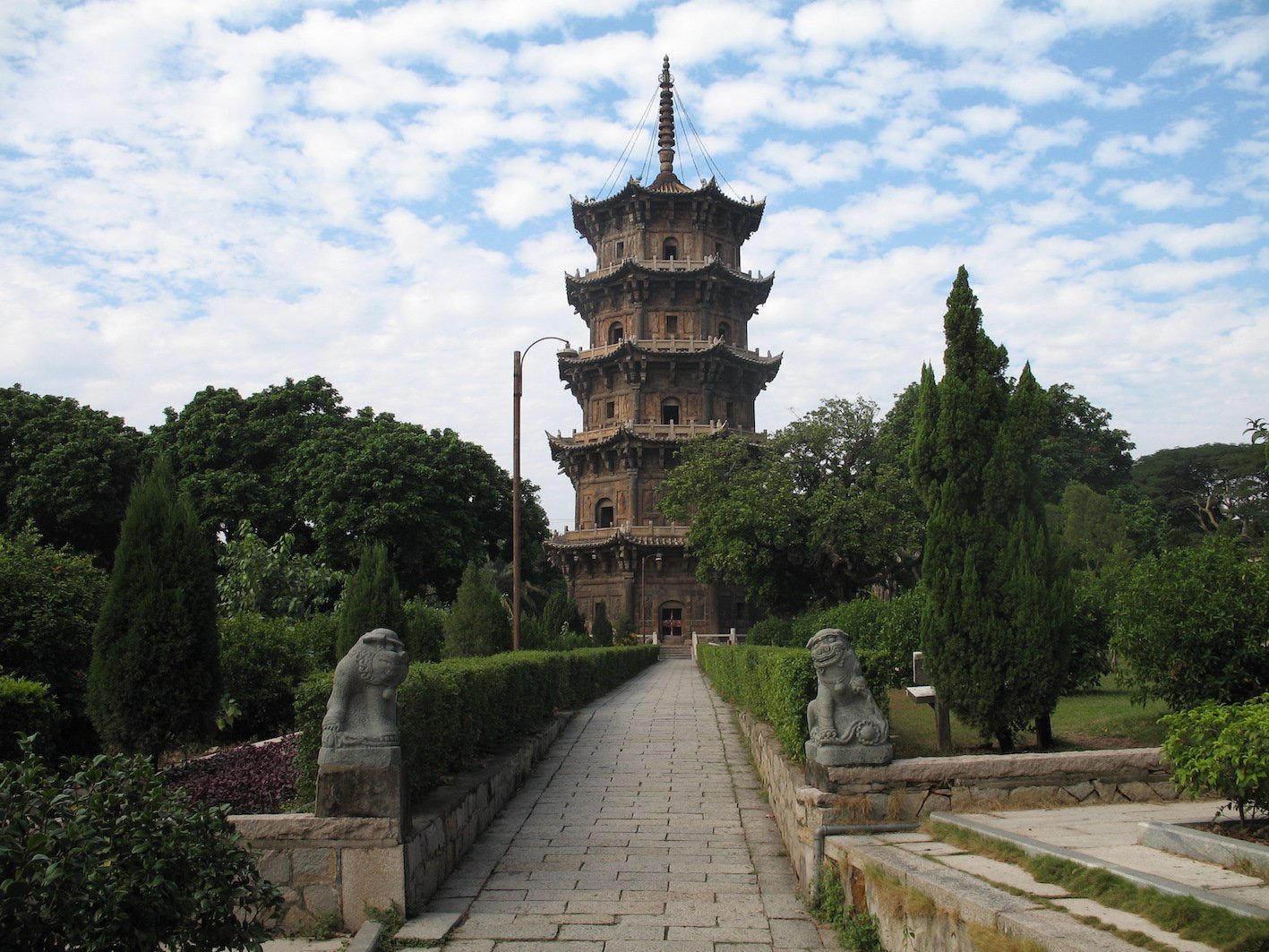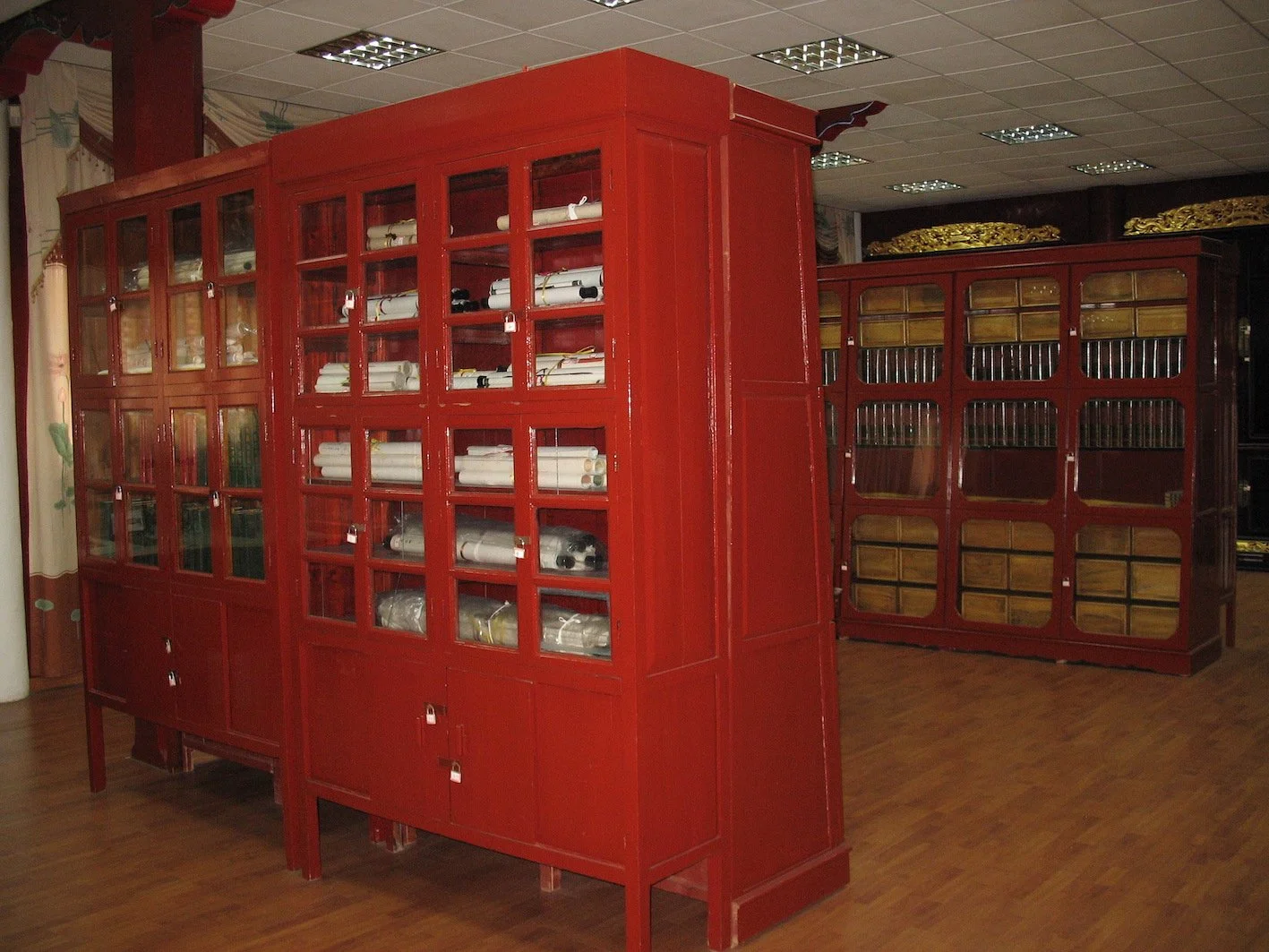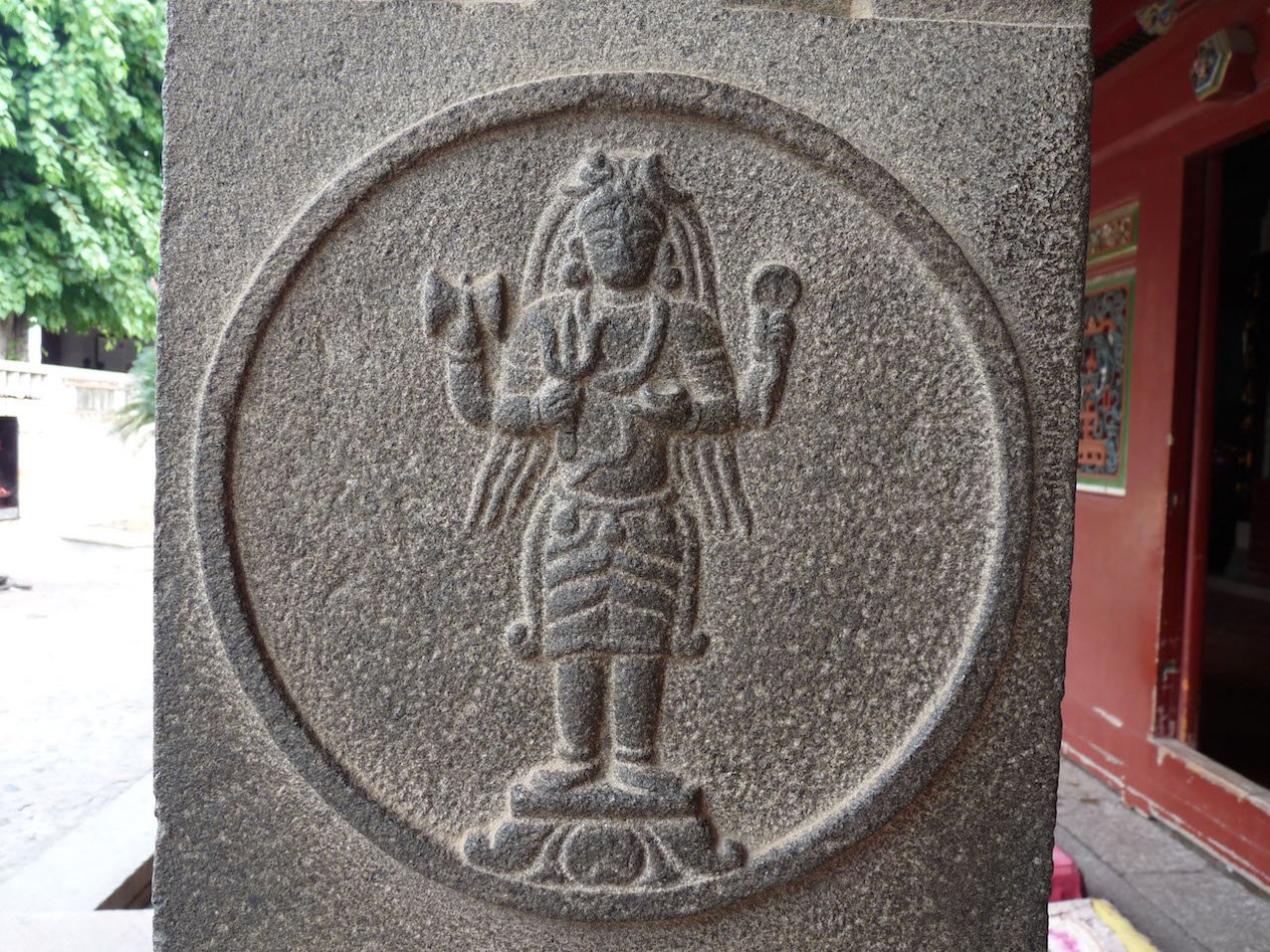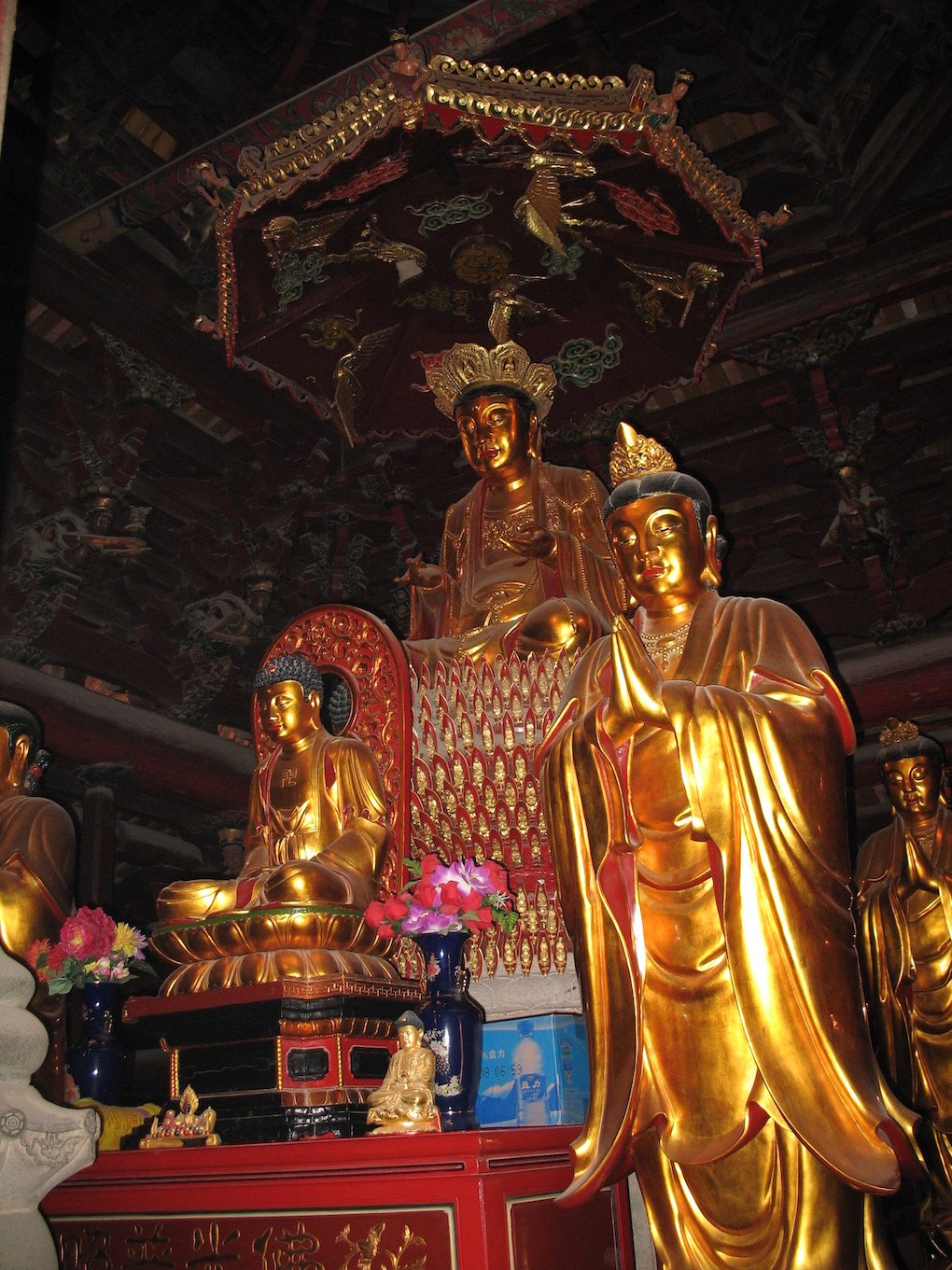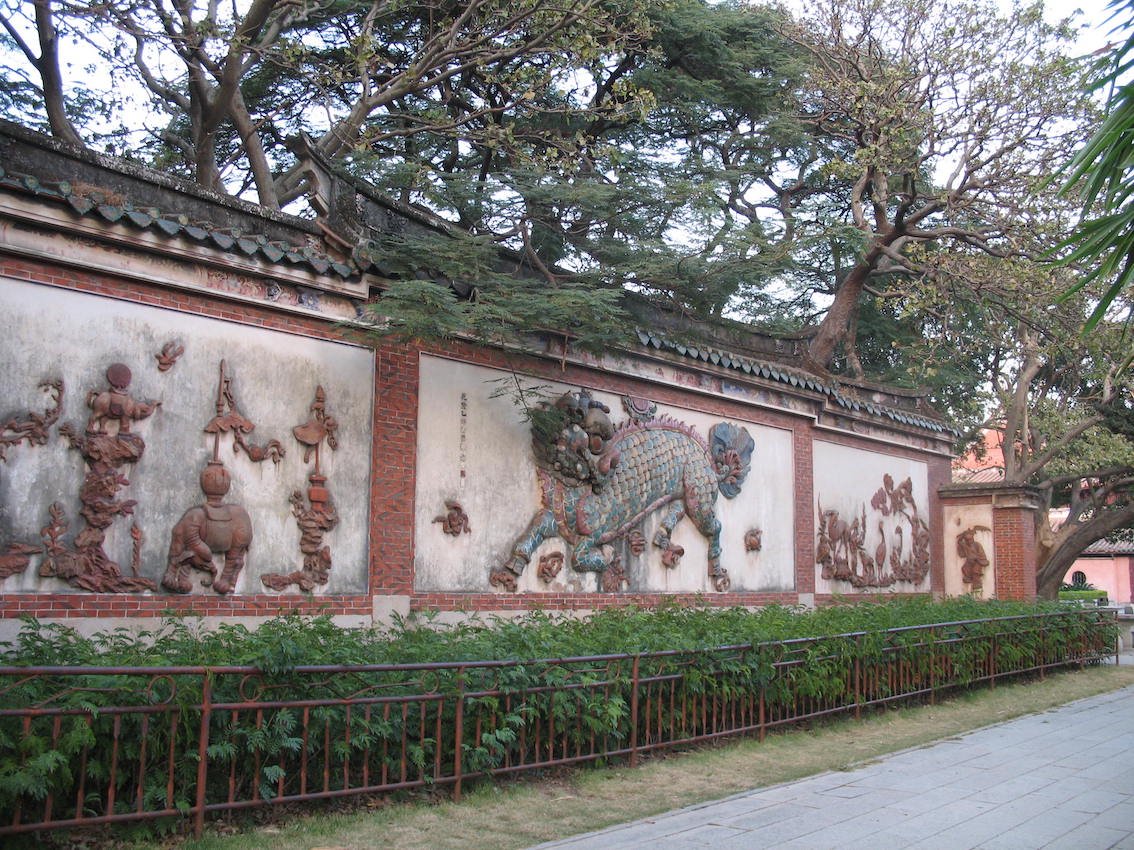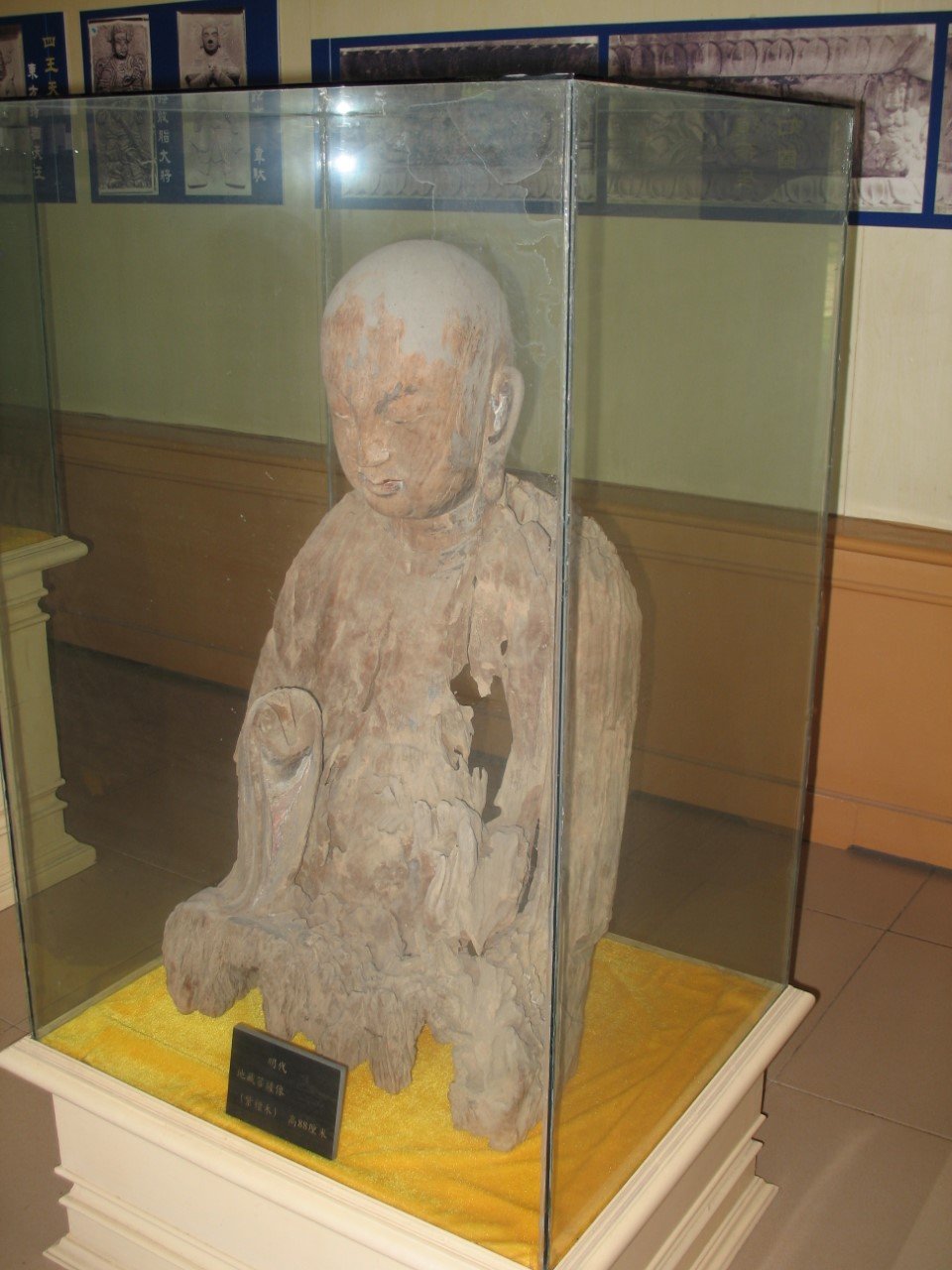Quanzhou Kaiyuan Buddhist Monastery in China
By Brian J. Nichols
Buddhist monasteries in China are home to sculptures, paintings, pagodas, texts, and relics dating back 1500 years or more. Although devastated by campaigns targeting religion during much of the twentieth century, including the Cultural Revolution (1966-1976), several monasteries were preserved and many became even more important as sites for curating items of cultural heritage. One such site is Quanzhou Kaiyuan monastery in Fujian Province on the Southeast coast of China.
Courtyard and main hall of Quanzhou Kaiyuan monastery.
Quanzhou Kaiyuan monastery was founded during China’s Tang Dynasty in 686 CE and has occupied the same urban location in the medieval port city of Quanzhou down to the present. This important monastery has amassed a collection of art and artifacts representing over 1300 years of history and now includes two museums. The most celebrated features of cultural heritage are two Song dynasty stone pagodas from the thirteenth century. There is a sutra library with a valuable collection of texts and a hall of patriarchs containing the purported mummy of a Tang dynasty monk from India named Zhiliang (ninth century). There is also a monumental Buddha hall dating from the seventeenth century and a twelfth century stone ordination platform protected by an ornate wooden hall containing many sculptures and artifacts. During the Cultural Revolution, the monastery was spared the destruction met by peer institutions and became a de facto site to collect other historic artifacts endangered by the fervor of Red Guards. Some of these items became part of the landscape of the monastery, while most became organized into a museum of Buddhist history which opened in 2001. A memorial hall dedicated to master Hongyi (1880-1942) is located on the monastery grounds as well. This site is thus a rich one to explore the topic of religious collections and museums.
Ven. Hongyi memorial hall.
The Stone Pagodas
One of two treasure box stupas in the main courtyard (1145 CE).
Pagodas serve as an important marker for a Buddhist monastery; they aspire heavenward and enshrine relics, texts, or objects representing the Buddha or the teaching of the Buddha (Wang 2000). The origin of pagodas in East Asia goes back to stupas in India originally used to memorialize the Buddha or relics of the Buddha or other saints. Kaiyuan has several ten to fifteen foot tall stone stupas, including nine “five wheel pagodas” from the early fifteenth century and two “treasure box” stupas dating to 1145. The “five wheel pagodas” are constructed with different layers including hexagonal and rounded, topped with a five rung finial. The treasure box stupas are said to be copies of bronze stupas cast by Qian Shu, king of the Wu-Yue kingdom in 955 (Ecke and Demiéville 1935: 87); they are decorated with carvings of Buddhist stories such as the Buddha in a previous life as a prince offering himself to feed a hungry tigress.
The most famous and visible structures at the monastery, however, are two towering stone pagodas. Having been destroyed and rebuilt several times after their initial construction in 865 and 916, the current east and west pagodas were completed in 1250 and 1237 respectively and rise to an impressive height of some one hundred and fifty feet. The pagodas are constructed entirely in local granite in a local style which imitates monumental construction in wood. Due to their similar height and appearance, Kaiyuan’s east and west pagodas are often called the twin towers, or the Purple Cloud Twin Pagodas. Each five-story pagoda is decorated with eighty life-size sculptures in middle relief depicting figures from Buddhist history and lore such as arhats, patriarchs, bodhisattvas, eminent monks and guardians. Among the more noteworthy figures on the west Pagoda are sculptures of the monkey king, Sun Wukong, and Guanyin (Avalokiteśvara) bodhisattva depicted as a male with a moustache, and on the east Pagoda a potbellied Xuanzang (602-664), the eminent pilgrim and translator, accompanied by a small monkey figure. The images of Sun Wukong and Xuanzang with the small monkey suggest knowledge of an oral tradition of the famous novel Journey to the West published anonymously in 1592, centuries after the construction of these pagodas. The greenstone reliefs along the base of the East Pagoda are especially noteworthy for both their artistic beauty as well as the knowledge of Indian Buddhist scripture they disclose. They illustrate several stories from the scriptures. Writing about these sculptures in 1935, Paul Demiéville noted, “Such a vivid and comprehensive 'Bible de pierre' [Bible of stone] is hardly to be found elsewhere in the Far East” (Ecke and Demiéville 1935, 81). The pagodas survived a destructive earthquake in 1604 with an estimated magnitude of 8.08 on the Richter scale; they have dominated the skyline until modern times and have become a symbol of the city.
The West pagoda (1237 CE).
Detail of the East pagoda (1250 CE), showing three carts escaping a burning house (the story of the burning house, from the Lotus Sutra).
The Sutra Library
A sutra library is a feature shared by many monasteries in China. Sutra libraries will typically hold a copy of the Chinese Buddhist canon and other Buddhist texts. They may also house other valuable objects that the monastery possesses. In such cases they may also serve as a kind of private or semi-public museum. At Kaiyuan, the library is closed to the general public; only monastics and their guests are allowed to enter the hall which houses a valuable collection of Buddhist texts. A copy of the Buddhist canon printed in 1641 is a centerpiece of the library. The most unique texts are pages of a sutra hand-written in gold from the tenth century sponsored by king of Min Wang Shenzhi, and pages of the Lotus Sutra written in blood by Ruzhao (d. 1331) in the fourteenth century. Rare texts include six printed sutras from the Song dynasty (960-1279). Special objects held in the library include an intricately carved wooden pagoda from the Ming dynasty and literati paintings and calligraphy from the same period. The library is not used for study or research; it is strictly a repository. The celebrated items are shown to distinguished visitors and the librarian monk regularly pays obeisance to the Tripitika and does so whenever the cabinet is opened, demonstrating a liturgical function rather than a scholarly one.
Library cabinets containing copies of the Buddhist canon.
The Buddha Hall and Hall of Patriarchs
Buddhist temples developed not only to accommodate monastics, but also to memorialize the Buddha in a Buddha hall at the center of the complex. Kaiyuan, like monasteries throughout East Asia, has a Buddha hall enshrining Buddha(s) at the center of the site. A unique feature of Kaiyuan’s main hall is the use of corbelled arches which provide support to structural beams carved into the form of angelic figures or kalaviṇkas, each having outstretched arms holding musical instruments or some cultural items such as paper and brush. There are twenty-four to represent the twenty-four divisions of a Chinese solar year. At the back of the hall are gilded statues of the eighteen arhats, with a statue of Guanyin in the middle dating to 1711. This Guanyin wears a crown with a small Amitabha seated in the middle of the crown and her hands form a relaxed meditation mudra. All of the statues are gilded and give off a golden shine. The line of columns along the back porch includes two stone columns moved from an abandoned Yuan dynasty (1271-1368) Hindu temple during the reconstruction of the main hall in 1637. Tamil merchants had established at least one Hindu temple in Quanzhou during the Yuan dynasty (Guy 2010), and these columns were repurposed in the structure of Kaiyuan’s Buddha hall. Each of these finely chiseled sixteen-sided columns of green limestone has twelve carvings including Śiva, Brahma, Krishna, and other figures and motifs from Hindu mythology. In addition, at the base of the large stone platform that fronts the hall we find a stretch of stone sphinx sculptures (human face with lion's body, known in Sanskrit as vyala-vari), thought to be similarly repurposed from the same or another abandoned temple. These architectural features generate a broad base of interest in the Buddha hall beyond Buddhist devotional or liturgical functions. They have become part of the artistic and cultural features of the site, available for observation and appreciation by the public. Such enjoyment is encouraged by tour guides and guidebooks, and monastic residents alike.
Hindu columns, main hall.
Detail of Hindu column.
A feature shared with other Chan or Zen monasteries is a hall of patriarchs, enshrining images or statuary representing Zen ancestors. Such halls are a means to preserve and inculcate lineages of transmission, an important feature of Chan self-understanding. Kaiyuan monastery enshrines a statue of the founding monk, as well as a lacquered figure said to contain the mummy of a ninth century Indian monk. Mummies of venerated monastics, understood as “full body relics”, have been part of Chinese Buddhism since at least the sixth century. They represent the accomplishment of those practicing the path and have helped monasteries attract patrons and protection (Ritzinger and Bingenheimer 2006). The Buddha hall and the hall of patriarchs, as well as the pagodas, express traditions of memorialization and veneration, a method of sustaining connections to past teachers and exemplars of the tradition through material media. These basic functions suggest parallels with the role played by museums.
Purported mummy inside the hall of patriarchs: Zhiliang (front) and founding monk Kuanghu (back).
Ordination Platform
The hall of the ordination platform is built over a stone platform dating from the twelfth century. The roof of the building is a complex octagonal style that comes to a central point. Similarly to the main hall, the structural arches supporting the roofing beams are uniquely carved into the form of twentyfour heavenly angels or apsaras holding musical instruments of local Minnan tradition; these, however, do not have wings; rather, flight is indicated by billowing hair and clothing. The platform serves as a base for an array of valuable sculptures that have been placed there over the centuries. On the first level of the platform, flanking each of the four entry points of the platform at each of the cardinal directions are two life-sized vajra guardians; these eight guardian figures were replaced in 2006. The most valuable object is a delicately crafted and gilded one-foot tall 1000-armed, 1000-eyed Guanyin statue made from a single piece of sandalwood in 1398; it is protected by a glass case and set on a lacquered table just behind a lower table for offerings. Just behind Guanyin on the third level is a brightly gilded standing Amitabha flanked by the legendary Tang dynasty monks Hanshan and Shide bearing characteristically playful expressions. Just behind these statues is a stone stupa said to contain seven Buddha relics brought from Fuzhou Gushan Temple (Wang 2008, 137). Behind this stupa is a gilded statue of Shakyamuni Buddha seated in meditation. On the highest level, on a pedestal, rising above all the other statues is a gilded Vairocana wearing a crown seated on a magnificent base of one thousand red lotus petals, each depicting a golden Buddha emerging from a golden lotus in three-quarters relief. The impressions made by these objects is a striking tangle of antique red, gold, and black. The hall also contains the large bell and drum which are used to announce the beginning and end of the day.
The 1000-armed Guanyin made from sandalwood (1398 CE).
These statues dating from the fourteenth to the nineteenth century are protected cultural relics. While the possession of valuable cultural relics leads to financial and political benefits for religious sites in China, their presence may also lead to disruptions of traditional religious functions. When an ordination was held at this site in 2001, wooden platforms had to be erected to the side of the hall for the ordinands, since the protected statues could not be moved to make room. This is an example of a loss of traditional function due to modern protections for cultural relics, another issue arising from the dual functions played by religious sites, liturgical and curatorial.
The ordination platform statuary.
Two Museums
During the early twentieth century, Kaiyuan was part of what has been called a Buddhist revival in mainland China. It was at this time that it came to host the celebrated vinaya master Hongyi who was accompanied by his attendant, Ven. Miaolian. Hongyi was a regular Renaissance man who became esteemed for his painting, calligraphy, seal carving, and musical compositions before becoming a scholarly monk dedicated to the monastic precepts. Hongyi passed away in Quanzhou, explicitly leaving his “estate” to the care of Miaolian. Miaolian, in turn, established a memorial hall to display the personal effects, art and calligraphy of master Hongyi. The memorial hall was redesigned and expanded in the early 2000s and now displays a priceless collection of artifacts including 22 photographs of Hongyi, calligraphy, paintings, and seal carvings by Hongyi, sheet music he composed, and copies of sutras he collected in Japan. The memorial hall for master Hongyi is a Buddhist version of an ancient Chinese custom of establishing memorial halls for the remembering and veneration of esteemed ancestors. Unlike ancestor shrines, memorials halls include artifacts and memorabilia associated with the individual, very much like a museum.
The entrance of the Hongyi memorial hall.
The interior of the Hongyi memorial hall.
During the Cultural Revolution, Kaiyuan was spared the destructive violence met by other religious sites. It became a site of national(istic) cultural pride and housed a local bureau of heritage management tasked with studying and preserving the historic and cultural artifacts of the site. Given the protected status of the monastery, it became a de facto site for collecting cultural and religious artifacts from all over the city, especially Buddhist ones. The largest objects collected that remain on site today include an elaborately decorated wall built in 1795 known as the Qilin Wall, featuring the kylin (J. kirin), a mythological being sometimes referred to as a Chinese unicorn; it has the head of a dragon, scales of a fish, hooves of an ox, and tail of a lion. The other large items include the stone ling star gate from Quanzhou’s Confucian temple, and four stone columns decorated with flowing dragons from the Xuanmiao Daoist temple. Other items include stone steles from various eras and eight cannon from the Ming (1368-1644) and Qing dynasties (1636-1912); among them was one from 1624 and another from 1842. Buddhist objects brought to the site include a stone dhāraṇi pillar from 854, and statues from various centuries. The latter were collected and displayed as a collection in a group of halls on the eastern side of the monastic complex dubbed the Quanzhou Museum of Buddhism.
Kirin wall.
The Quanzhou Museum of Buddhism opened on the grounds of Kaiyuan in 2001 and contains interpretive signs introducing eras of Buddhist development in Quanzhou, important figures in local Buddhist history, and special features of Buddhism in Southern Fujian, such as the tradition of “vegetarian aunties” (caigu). “Vegetarian aunties” are lay women who shun marriage or are widowed and adopt a Buddhist identity and vegetarian diet without becoming nuns. Some notable items include three stone sculptures from the Tang dynasty, including a Guanyin with moustache that was once set in a niche of the pagodas, and a wood panel engraved with an image of Amitabha Buddha from 1275, a purple sandalwood sculpture of Dizang bodhisattva from the Ming, an excellent stone sculpture of Bodhidharma from the Ming, gilded bronze statues from the Ming and Qing, a large steel tripod cast by Zheng Zhilong (1604-1661) in 1637 (one of five), large bronze bells from 1132 and 1325 as well as bronze and iron bells from the Ming and Qing dynasties.
Buddhist museum, exterior.
Buddhist museum, interior.
Stone Bodhidharma in the Museum of Buddhism (Ming dynasty).
Red sandalwood Dizang Bodhisattva in the Museum of Buddhism (Ming dynasty).
It should be noted that this latest development is qualitatively different from previous forms of collecting. Interpretive display of curated objects is similar to the organization of memorial halls for departed exemplars, but remains distinctively secular given the lack of devotional features such as kneeling cushions or incense burners. Nonetheless, museums of this kind enhance the pedagogic and cultural value of a site by sharing artifacts and information with the public. In the case of Kaiyuan the museum serves as an annex to the temple complex as a whole without encroaching upon the devotional and liturgical centers of the site. This is a pattern seen at other Buddhist monasteries that have developed museums to display valuable artifacts, such as Famen Temple outside Xi'an or Zhongtai shan and Foguang shan in Taiwan. Such developments seem to be increasingly important as Buddhist temples develop as centers of education including the presentation of art and artifacts.
Front gate of monastery.
Museumification may also serve to diminish the religious function and character of a site. There are, for example, Buddhist temples in China that have been converted into secular museum spaces and do not support monastics or devotees. Yangzhou’s Tianning Temple is now called the Yangzhou Buddhist Culture Museum, and Ningbo’s Baoguo Temple is presented as a museum of ancient architecture. Neither site supports devotional or liturgical practices which lie at the center of functioning Buddhist temples in China. In such cases, it would seem that the State and other elites in the community have engaged in what Talal Asad has called "projects of modernity" that serve to advance and institutionalize secularization (2003). In the case of contemporary China, such efforts may be seen as in line with the orthodox socialist view that religion is destined to become an object of history, existing only in museums. Nevertheless, the preservation of religious objects and material features, even in a museum, serves as a resource for education about and inculcation of religious ideas, values, and traditions.
Baoguo Temple Ancient Architectural museum.
Acknowledgements
I am grateful for the support of the Fulbright foundation and the Asian Cultural Council for their financial support of fieldwork related to this project. This project also benefited from the Woodenfish in China program (2009, 2012) and the University of British Colombia's Buddhist Studies 2009 Summer Program in China.
All photos by the author.
References
Asad, Talal. 2003. Formations of the Secular: Christianity, Islam, Modernity. Stanford, CA: Stanford University Press.
Ecke, Gustav, and Paul Demiéville. 1935. The Twin Pagodas of Zayton. Cambridge, MA: Harvard University Press.
Guy, John. 2010. "Quanzhou: Cosmopolitan City of Faiths." In The World of Khubilai Khan: Chinese Art in the Yuan Dynasty, edited by James C. Y. Watt, 159-178. New York: Metropolitan Museum of Art.
Ritzinger, Justin, and Marcus Bingenheimer. 2006. “Whole-Body Relics in Chinese Buddhism.” Indian International Journal of Buddhist Studies 7:37–94.
Wang, Chen-shan (Ellen). 2008. “Quanzhou Kaiyuan Monastery: Architecture, Iconography and Social Contexts.” PhD diss., University of Pennsylvania. StableURL:http://proquest.umi.com/pqdweb?did=1537005891&sid=1&Fmt=2&clientId=480&RQT=309&VName=PQD
Wang, Eugene. 2010. “Pictorial Program in the Making of Monastic Space.” In Buddhist Monasticism in East Asia, edited by James A. Benn, Lori Meeks, and James Robson, 65–106. New York: Routledge.
Dr. Nichols is an associate professor in the department of Humanities and coordinator of the religious studies program at Mount Royal University in Calgary. He holds a Ph.D. in religious studies with a concentration in Buddhism from Rice University. His forthcoming book Lotus Blossoms and Purple Clouds: Monastic Buddhism in Post-Mao China, published by University of Hawai'i Press, draws on ethnographic study and non-canonical sources to broaden the conception of Buddhist monasticism as a lived tradition. His interests include Buddhism in contemporary China, material and spatial studies of religion, and the emerging fields of ecodharma and contemplative studies.
